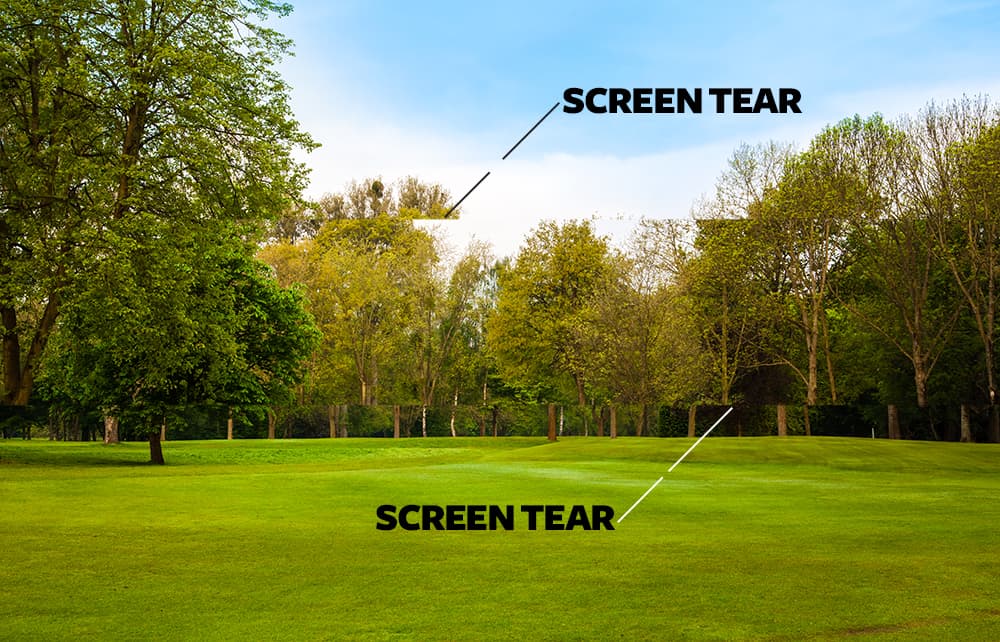Screen tearing is a common problem associated with monitors. It is the disparity between the graphics processing unit’s (GPU) frames per second (FPS) and the monitor’s refresh rate (measured in Hz); Frame rate exceeds the refresh rate.
Manifesting as a horizontal line splitting the displayed image, at one or more places, screen tearing can result in a less than perfect user experience when watching videos or playing video games.
Table of Contents
What Is Screen Tearing?

Simply put, screen tearing occurs when the display (monitor) is not synchronized with the Graphics Processing Unit (GPU).
To better understand this occurrence, you need to understand the relationship between the display and the GPU.
Basically, images are displayed on computer monitors as single still frames. To depict motion, the images are repeatedly rendered on the screen over and over again, with slight changes to each new render. The monitor receives control signals from the GPU.
Screen tearing results from the interaction between the monitor/display and the GPU. It occurs when the GPU and display are working out of sync with each other.
Whenever an image is sent from the GPU to the display, the display unit starts rendering it – this process is not instantaneous. If the GPU sends another image before the display has finished rendering the initial image, it is forced to continue the rendering process using the new input/information. This results in a torn screen or mixed image.
The rate at which the GPU sends images to the display is dependent on each video’s frame rate or FPS (Frames Per Second). On the other hand, the rate at which the display pulls images from the GPU is dependent on its refresh rate. A 60Hz display is capable of pulling up to 60 frames/images from the GPU per second.
The main reason why these two systems may not be in sync is due to the fact that monitors render images at a fixed rate while the GPU sends new images to the display at varying rates- depending on the frame rate (FPS) of different scenes on a video.
As such, it is important to note that screen tearing occurs whenever the display and GPU are not in sync, regardless of whether the monitor refreshes slower or faster than the GPU’s rate of sending new information. This phenomenon is bound to occur whenever these two are loading at different speeds.
How to Prevent Screen Tearing?
You can prevent or minimize screen tearing in a number of ways, including:
1. Monitor Refresh Rate
One of the simplest and most basic ways to prevent screen tearing is by matching your monitor’s refresh rate to the GPU’s frame rate. If you have a monitor that has a high refresh rate (frequency), and want the display to pull fully rendered images from the GPU every time it refreshes, consider capping its refresh rate to the GPU’s FPS.
This is a great solution if you are getting a torn screen simply because your GPU is not able to match your monitor’s faster refresh rate; or playing games, or videos, that also have a capped FPS which can be matched by capping your monitor’s refresh rate.
However, it is worth noting that screen tearing will still occur whenever the GPU’s frame rate exceeds the monitor’s refresh rate.
2. Frames Per Second (FPS)
Another way to prevent screen tearing is by limiting your GPUs frame rate (FPS). If you are experiencing screen tearing because your GPU’s frame rate is consistently outpacing your monitor’s refresh rate, you can eliminate it by simply capping the FPS.
Capping the frame rate by a multiple of the monitor’s refresh rate eliminates screen tearing by creating a buffer of the output from the GPU.
It is worth noting that while this solution does prevent screen tearing, it may lead to screen stuttering, where one frame/image is displayed repeatedly, as the display waits to refresh; This results in input lag.
3. G-Sync
Considered to be one of the most effective ways of preventing screen tearing without a significant impact on input lag, G-Sync is a hardware module installed in specific monitors. This technology is designed to force the display and the GPU to work in sync with each other.
This technology relies on Variable Refresh Rate to eliminate the occurrence of screen tearing. Simply put, G-Sync normally works to synchronize the GPU output with the display input by varying the refresh rate of the display to match the Graphics Processing Unit’s frame rate, dynamically.
During video playback or when playing video games, G-Sync eliminates screen tearing as long as the highest refresh rate (frequency) of the monitor is not exceeded. Furthermore, all of this is achieved with the least amount of input lag, all thanks to its variable overdrive feature.
However, it is worth noting that you need to have an NVIDIA graphics card to use G-Sync. This solution is also quite pricy as a result of the components used to manufacture it.
4. FreeSync
To eliminate screen tearing, FreeSync provides a Variable Refresh Rate by using the AdaptiveSync protocols of HDMI and DisplayPort. An AMD technology, FreeSync only works with compatible monitors and GPUs.
Just like G-Sync, this technology works to ensure that the GPU does not send any new images to the display before the rendering of previously sent images/frames is complete. To eliminate screen stuttering, which occurs when the frame rate of the GPU goes below the dynamic refresh range of the monitor in use, FreeSync turns itself off automatically – when the frame rate dips below the applicable range.
While FreeSync is not as costly as G-Sync, it is also not as effective. For instance many, G-Sync monitors are known to have a narrow dynamic refresh range. As such, buyers must be careful when shopping for these monitors, making sure that they look for those with a wider ranger.